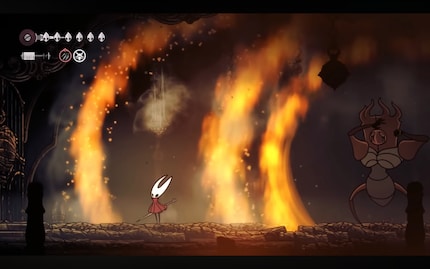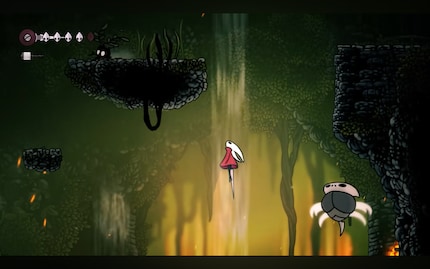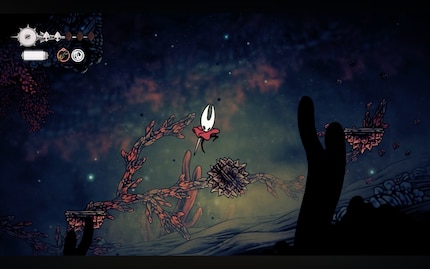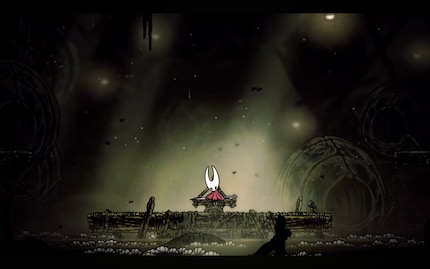
Background information
Henry Halfhead: Swiss game with a good head on its shoulders
by Philipp Rüegg

Hollow Knight: Silksong is a constant battle between pure amazement and the irrepressible desire to smash my controller. And that’s exactly why it’s brilliant.
He lies there, motionless. The Last Judge, that merciless boss of the Blasted Steps, has finally passed judgment on himself after 16 agonisingly long tries.
My last hour and a half was a masterclass in how not to fight a boss. Attempts one through eight: too greedy, always risking one strike too many. Attempts nine through twelve: I was already thinking about dinner while my fingers were digging Hornet’s grave. Attempt 13: a brief WhatsApp distraction. Bam, dead. Attempts 14 and 15: a mix of both, garnished with creative slurs my children shouldn’t ever hear. But attempt 16? Pure, concentrated perfection. Or maybe just luck. No matter, I won – and that’s all that counts.

Hollow Knight: Silksong is frightfully hard, I’m frightfully mediocre, and yet I love it – most of the time at least. Although I’ve been immersing myself in the fantastic Pharloom almost every day for the last few weeks, I still haven’t finished the game. I just needed breaks occasionally, otherwise I’d have gone crazy.
Nevertheless, Team Cherry has done it again. They’ve created a masterpiece. A beautiful, demanding masterpiece I’d love to smash against the wall.
From its very first frame, Silksong feels familiar yet refreshingly new. Hornet’s control scheme is a revelation. Where my Knight from the original was stoic and methodical, Hornet’s a whirlwind. She’s faster, more agile, her dances with needle and thread are a feast for the eyes. Whizzing through the air, jumping off walls and attacking enemies with a nimble precision that makes her predecessor seem almost sluggish. It’s pure gameplay gold.

And then there’s Pharloom. This new world isn’t a copy of Hallownest. It’s louder, more colourful, livelier – and simply beautiful. From moss-covered forests to gleaming golden cities, every screen bursts with detail and atmosphere.
The world isn’t just bigger, but more vertical as well. This, combined with Hornet’s agility, adds a whole new sense of exploration. The new equipment system for active and passive skills adds another strategic layer I wouldn’t want to miss. It’s everything I loved about Hollow Knight on steroids.

The beautiful visuals and ingenious gameplay are complemented by a superb soundtrack. Christopher Larkin provided it once again, as well as the phenomenal sound design. Pharloom is alive, visually and acoustically. Every rustle or hiss is interwoven with its surroundings, giving me an inkling of what to expect.
I love a challenge. In Hollow Knight, I mastered the trials in the Colosseum of Fools, conquered the White Palace and defeated the Absolute Radiance. I thought I was ready for Silksong. How foolish…
Silksong doesn’t even try to give you training wheels. Enemies are more aggressive, their attack patterns more complex and the bosses… look cool, but are brutal. Sure, I’ll knock down a few early critters on attempt one, but others drive me to the brink of despair. Mind you, each of my deaths is fair: one wrong dodge, one attack too many. It’s my fault. The game keeps whispering in my ear: «Git gud.»

This brutal difficulty is my main point of criticism – only worsened by endless backtracking to bosses. The faster pace is both a blessing and a curse. On the one hand, the game flows amazingly. On the other, it leaves hardly any room for mistakes. Whereas Hollow Knight often granted me moments to heal, Silksong has me fighting for opportunities every millisecond. For veterans, this might be the ultimate rush. But for me, it’s a balancing act between euphoria and the desire to dismantle my controller into its individual components.
I’m caught in a loop of admiration and frustration. Whenever I switch off my console, I swear I’ll never touch that sadistic game again. But ten minutes later, I’m just sitting in front of it again. I know I can do it. Because that one moment when a boss finally falls after attempt fifty is simply priceless.
Silksong isn’t a game for everyone. It requires a masochistic streak and demands everything from you: patience, precision and a high tolerance for frustration. It’s a game that pushes you to your limits, but rewarding you with one of the most fascinating game worlds and gameplay out there.
Silksong I love and hate you – and that’s why you’re so darn good.
From big data to big brother, Cyborgs to Sci-Fi. All aspects of technology and society fascinate me.
Interesting facts about products, behind-the-scenes looks at manufacturers and deep-dives on interesting people.
Show all